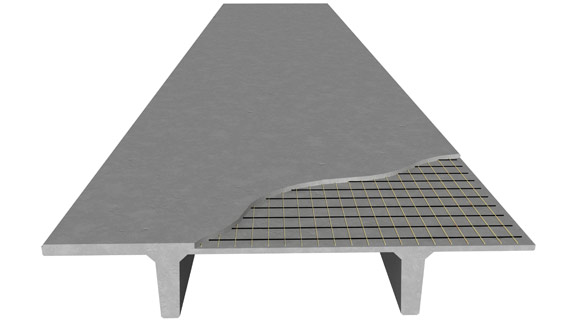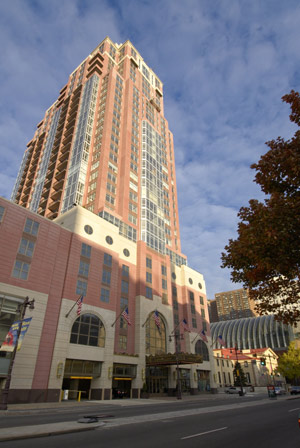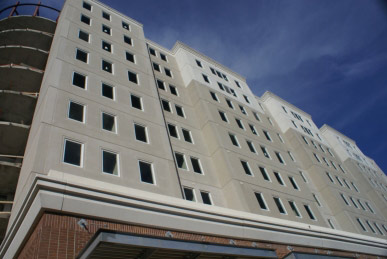This post was guest blogged by Michael Drabenstott, the communications director for AltusGroup, a partnership of precast concrete manufacturers dedicated to advancing innovative precast technologies. Drabenstott has been writing about building products for construction industry publications for more than 15 years.
The same attributes that make carbon fiber ideal for aerospace, athletic, automotive and other applications also makes it desirable in the construction industry. That’s especially true in precast concrete – large pieces of concrete that are manufactured in a factory and shipped to a construction site. Carbon fiber’s high strength, light weight and resistance to corrosion make it an ideal reinforcing material.
In 2003 group of precast concrete manufacturers partnered with carbon fiber grid provider Chomarat North America to form AltusGroup. AltusGroup members use Chomarat’s C-GRID®, as the carbon fiber epoxy based reinforcing in several precast building system products to enhance the strength and reduce the weight of precast concrete.
Since 2004, nearly 300 projects representing over 15 million square feet of surface and deck area have been constructed in the United States. All contain carbon fiber grid as a reinforcing or strengthening material.
Carbon fiber grid has been successfully incorporated into in many precast concrete products, which are marketed under the CarbonCast® brand name
- Insulating architectural panels for exterior building walls: Carbon fiber grid is used in the panel face to replace steel mesh reinforcement and as a mechanical link to the outer and inner sections of the concrete wall.
 Non-corrosive carbon fiber grid reinforcement in the wall panel face allows precasters to use less concrete, which reduces weight and raw material usage.
Non-corrosive carbon fiber grid reinforcement in the wall panel face allows precasters to use less concrete, which reduces weight and raw material usage.
- High-performance insulated sandwich wall panels for building exteriors: Carbon fiber is used as a shear grid or shear truss to connect the inner and outer concrete wythes of sandwich wall panels, creating a fully structurally composite, thermally efficient unit.
- Corrosion-resistant double tees for parking garages: Carbon fiber grid is integrated as reinforcing in the double tee deck to replace conventional steel mesh.

Replacing welded wire mesh with carbon fiber grid in the decks of precast parking garage components reduces weight and the need for chemical protection.
The use of carbon fiber grid as reinforcement in precast concrete delivers a variety of benefits depending on the application. In most cases, they represent improvements over conventional steel reinforcing while maintaining the generally accepted benefits of precast concrete.
Non-corrosiveness: Because carbon fiber will not oxidize, it will not cause rusting, staining or spalling as can occur with steel reinforcing. Consequently, precasters can reduce the amount of concrete cover—three inches or more in the case of some wall panels—that would have been required to protect the reinforcing.
Weight: As noted previously, the opportunity to reduce the amount of concrete cover can lead to significant weight reductions: up to 50% in wall panels and up to 8% in double tees. For architects and engineers, reduced weight contributes to cost savings starting with foundations and building superstructure and extending to lower shipping costs and crane expenses.

Symphony House in Philadelphia used wall panels with carbon fiber grid reinforcing. The wall panels weighed about 40% less than conventional six-inch thick precast.
Thermal efficiency: The use of carbon fiber grid enables significantly improved thermal performance. Because carbon fiber has low thermally conductivity, it reduces the transfer of heat or cold from outside to inside and vice versa. The insulation embedded in the walls can deliver 100 percent of its rated performance without hot spots or cold spots. As a result, building owners can benefit from long-term energy savings and a smaller investment in HVAC equipment.

Wall panels with R-12 insulation on dorms at Georgia State University in Atlanta saved $700,000 in HVAC costs.
Environmental friendliness: Carbon fiber grid reinforced precast products are typically more environmentally friendly than other envelope enclosure options. They use local materials and less concrete. Their thermal efficiency reduces HVAC expenditures and saves energy. They do not require VOC-emitting paints or finishes. And they last longer and can be recycled.
Of course, carbon fiber grid costs about twice as much as conventional steel reinforcing it replaces. But that’s usually more than offset by reductions in concrete and chemical treatments that would have protected the steel, as well as lower HVAC demands and the possibility of reducing the building foundation and substructure.
Additionally, precasters have had to reconfigure their manufacturing procedures to change over from steel mesh to carbon fiber. With the double tee product, this challenge actually resulted in opportunity: precasters collaborated and engineered an automatic embedment machine that speeds fabrication and enhances quality.
With the drive for green, sustainable building products that can reduce the global carbon footprint, the use of carbon fiber grid in precast concrete is beginning to make an impact on the construction industry.